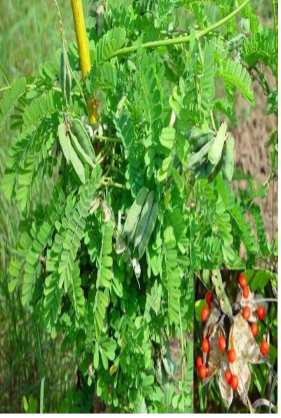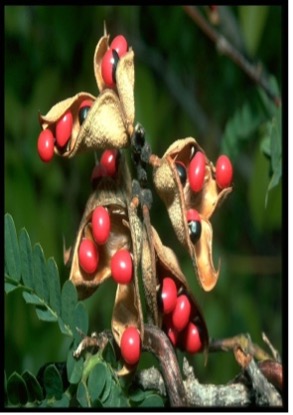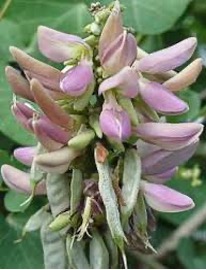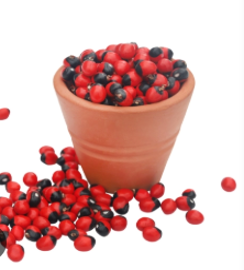HERBAL GARDEN
Vivek college of Ayurvedic Sciences & Hospital Bijnor UP
गुंजा




Classification
Synoyms
Gunja (Sanskrit)
Ratti (used as weight standard in ancient India)
Krishna Gunja (black variety), Shweta Gunja (white), Rakta Gunja (red)
Jequirity bean
Chanothi (in regional languages)
Habit
Climbing, twining herbaceous vine
Habitat
Widely distributed in tropical and subtropical regions of India and other Asian countries. Grows wild in bushes, forests, field margins, and hedges.
Morphology
- A slender, perennial, twining climber
- Leaves: Alternate, pinnately compound with 5–15 pairs of leaflets
- Flowers: Small, pale violet to pink, papilionaceous, in clusters
- Pods: Flat, oblong, 2–4 cm long
- Seeds: Bright red with a black spot (Rakta Gunja), highly attractive but toxic
Chemical Composition
Abrin – highly toxic toxalbumin , Glycyrrhizin-like compounds , Flavonoids , Alkaloids , Triterpenoids , Abrine (alkaloid) , Proteins, Saponins , Fixed oils
Guna-Karma
Rasa-Tikta , Kashaya
Guna–Laghu , Tikshna
Virya-Ushna
Vipaka–Katu
Karma –Vedanasthapana
, Shothahara
, Lekhana
, Vrishya
, Kaphahara
, Kushtaghna
Doshakarma –Kapha-Vatahara
Medicinal uses
Seed powder (purified) used in joint pain, arthritis, and paralysis.
Used externally as paste for skin diseases, eczema, vitiligo, and alopecia.
White variety is used as aphrodisiac and in infertility treatments (after purification).
Effective in toothache (seed paste applied externally).
Root and leaves are used in fever, cough, and as an emetic (in small doses).
Leaves have mild expectorant and anthelmintic action.
Useful Part
Seeds (after purification), Root, Leaves
Doses
Seed powder (Shodhita): 30–125 mg
Root powder: 1–3 g
Leaf juice: 10–15 ml
Important Formulation
Gunja Taila
Gunja Lepa
Gunja Beeja Churna
Kushta-hara yogas
Shloka
गुञ्जा तिक्तोष्णा तीक्ष्णा कुष्ठार्तिशोथवातनुत् |
लेखनी च कफघ्नी च व्रणेषु परमौषधम् ||
Hindi Name
रत्ती
English Name
Indian Licorice / Rosary Pea / Jequirity
Botanical Name
Abrus precatorius Linn.
Family
Fabaceae (Leguminosae)